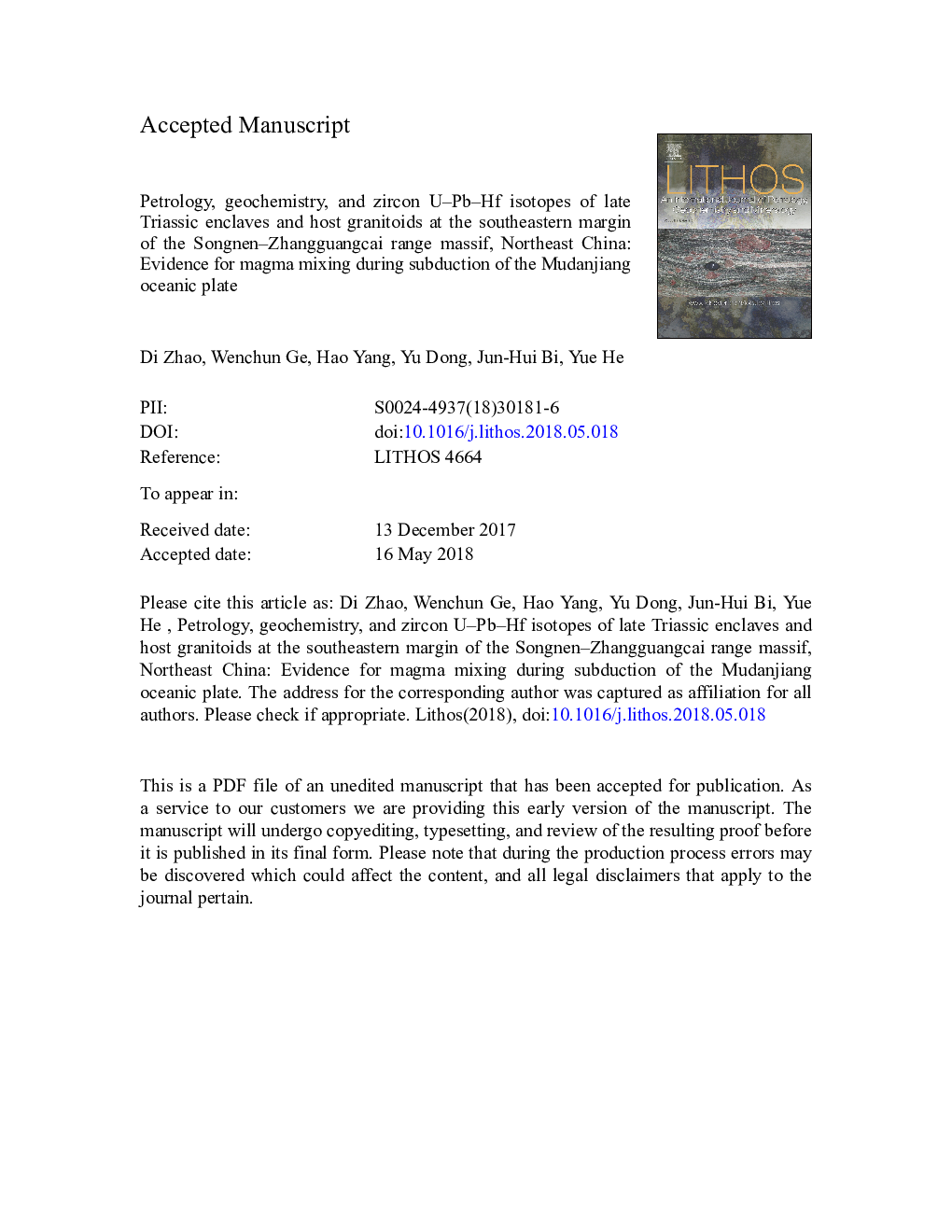| کد مقاله | کد نشریه | سال انتشار | مقاله انگلیسی | نسخه تمام متن |
|---|---|---|---|---|
| 8911598 | 1638618 | 2018 | 53 صفحه PDF | دانلود رایگان |
عنوان انگلیسی مقاله ISI
Petrology, geochemistry, and zircon U-Pb-Hf isotopes of Late Triassic enclaves and host granitoids at the southeastern margin of the Songnen-Zhangguangcai Range Massif, Northeast China: Evidence for magma mixing during subduction of the Mudanjiang oceanic
دانلود مقاله + سفارش ترجمه
دانلود مقاله ISI انگلیسی
رایگان برای ایرانیان
کلمات کلیدی
موضوعات مرتبط
مهندسی و علوم پایه
علوم زمین و سیارات
ژئوشیمی و پترولوژی
پیش نمایش صفحه اول مقاله

چکیده انگلیسی
We report zircon U-Pb ages and geochemistry (major and trace elements, mineral compositions, and Hf isotopic compositions) for the Hailin pluton in the southeastern Songnen-Zhangguangcai Range Massif, northeastern China, to constrain the role of magma mixing in its petrogenesis and to reconstruct the tectonic evolution of the Mudanjiang Ocean. Zircon U-Pb dating yields ages of 215â¯Â±â¯1â¯Ma, 217â¯Â±â¯1â¯Ma, and 219â¯Â±â¯1â¯Ma for the host granitoids of the Hailin pluton, and 221â¯Â±â¯1â¯Ma for mafic microgranular enclaves (MMEs) within the granitoids, indicating they were emplaced coevally. The host granitoids are characterized by 63.18-70.44â¯wt% SiO2 and 0.69-1.94â¯wt% MgO, and are depleted in high field strength elements (HFSEs; e.g., Nb, Ta, and Ti) and heavy rare earth elements (HREEs), and enriched in large ion lithophile elements (LILEs; e.g., Rb, Sr, and Ba) and light rare earth elements (LREEs). The zircons in the host granitoids yield two-stage model ages of 1058â¯Ma to 1770â¯Ma, together with εHf(t) values of â6.6 to +3.1. These results indicate that the host granitoid magmas were generated by partial melting of Mesoproterozoic lower crust contaminated by ancient crustal material. The MMEs have a restricted SiO2 range (47.61-57.4â¯wt%), high contents of Ni, Co, and Cr, and high Mg# values (42-54). They have higher Fe2O3T, MgO, Cr and Co contents than the host granitoids, as well as higher total rare earth element (REE) concentrations. Their REE patterns are sub-parallel to those of the host granitoids, characterized by enrichments in LILEs and LREEs, and depletions in HFSEs and HREEs. Zircons from two samples of the MMEs yield single-stage Hf model ages of 666-1077â¯Ma and εHf(t) values of â5.4 to +5.2. The geochemical characteristics of the MMEs are similar to those of the host granitoids, indicating crust-mantle interaction during their formation. The mafic magmas were derived from melting of depleted lithospheric mantle that had been metasomatized by slab-derived fluids. MMEs are common in the host granitoids and are characterized by irregular spheroidal shapes, with sharp, rounded, or irregular transitional contacts, acicular apatites, and plagioclase reverse zoning, suggesting the importance of magma mixing during petrogenesis. Our geochemical and isotopic data suggest that the Late Triassic Hailin pluton formed by the mixing of felsic and mafic magmas in an active continental margin setting, closely related to the westward subduction of the Mudanjiang oceanic plate beneath the Songnen-Zhangguangcai Range Massif.
ناشر
Database: Elsevier - ScienceDirect (ساینس دایرکت)
Journal: Lithos - Volumes 312â313, July 2018, Pages 358-374
Journal: Lithos - Volumes 312â313, July 2018, Pages 358-374
نویسندگان
Di Zhao, Wenchun Ge, Hao Yang, Yu Dong, Junhui Bi, Yue He,